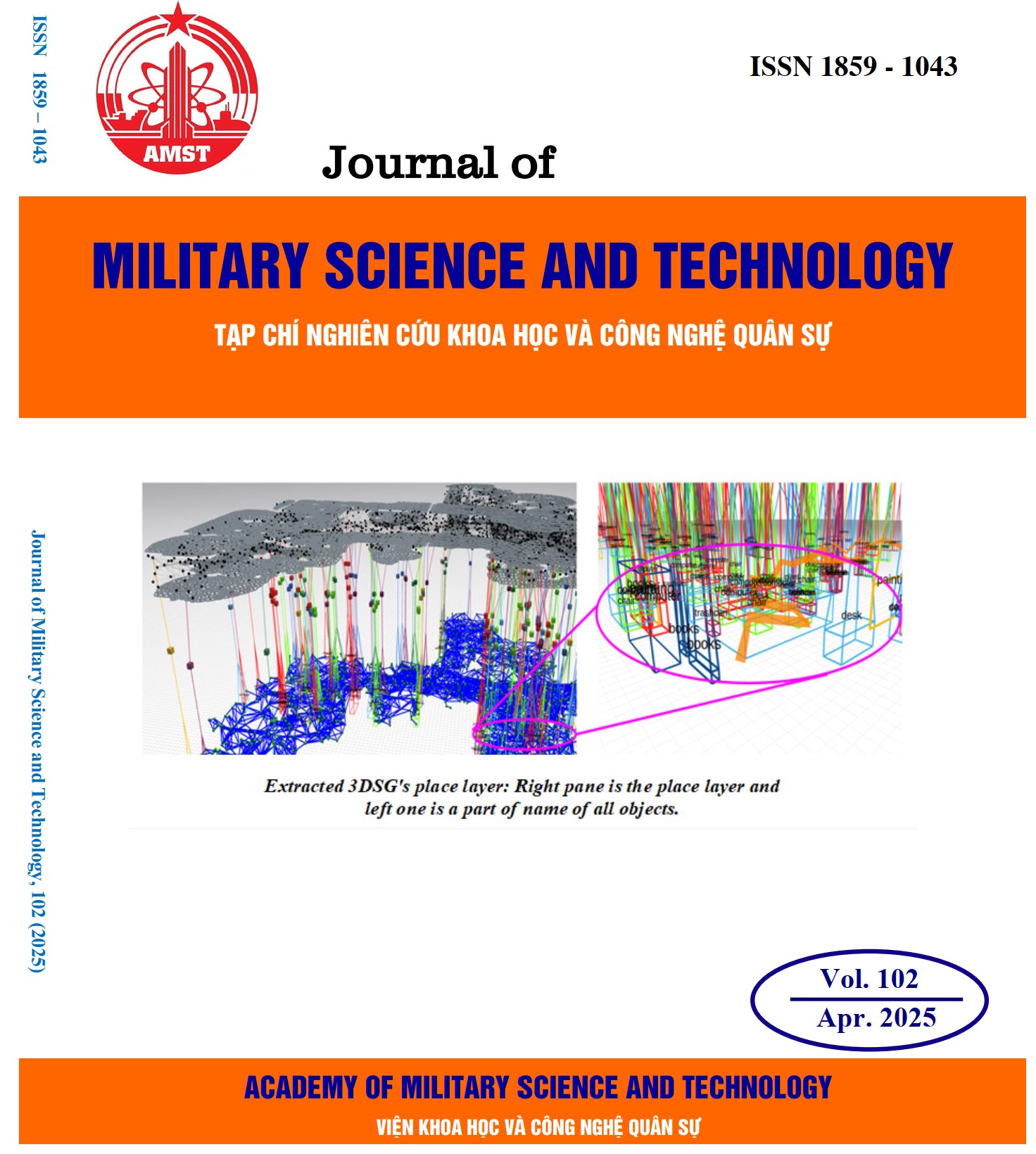Phân tích hiệu suất của hệ thống treo bán chủ động trên xe điện với giảm chấn gia tốc
380 lượt xemDOI:
https://doi.org/10.54939/1859-1043.j.mst.102.2025.164-172Từ khóa:
Xe điện; Hệ thống treo bán chủ động; ADD; Thuật toán đom đóm; Êm dịu.Tóm tắt
Để nâng cao độ hiệu quả độ êm dịu của hệ thống treo bán chủ động của một xe điện, một mô hình động lực học của xe điện với 5 bậc tự do được đề xuất để phân tích ảnh hưởng của chúng đến độ êm dịu. Một hệ thống treo bán chủ động với bộ điều khiển giảm chấn theo hướng gia tốc, (ADD- Acceleration-Driven Damping) được đề xuất cho việc nâng cao hiệu quả êm dịu của hệ thống treo bán chủ động. Thuật toán đom đóm được sử dụng để tối ưu hiệu quả êm dịu của hệ thống treo bán chủ động. Các giá trị bình phương bình (RMS) của gia tốc thẳng đứng của ghế ngồi người điều khiển (aws), gia tốc thẳng đứng tại vị trí thân xe (awb) và gia tốc lặc dọc thân xe (awphi) được lựa chọn như là các hàm mục tiêu dựa tiêu chuẩn quốc tế ISO 2631:1997(E). Các kết quả đạt được chỉ ra rằng, các giá trị aws, awb và awphi lần lượt giảm 12.07%, 6.85%, và 21.47% so với hệ thống treo bị động của xe nguyên bản khi ô tô chuyển động trên mặt đường ISO cấp B với vận tốc 20 m/s và đầy tải. Ngoài ra, hiệu quả êm dịu của hệ thống treo bán chủ động đề xuất được kiểm chức dưới điều kiện vận tốc khác nhau.
Tài liệu tham khảo
[1]. Q. Chen et al. “Research and development of in-wheel motor driving technology for electric vehicles”. International Journal of Electric and Hybrid Vehicles, Vol.8, pp. 242–253, (2016). DOI: https://doi.org/10.1504/IJEHV.2016.080024
[2]. L.R .Miller. “Tuning Passive, Semi-active and fully active suspension systems”. In Proceedings of the 27th IEEE Conference on Decision and Control, Austin, TX, USA, Vol.3, pp. 2047–2053, (1998). DOI: https://doi.org/10.1109/CDC.1988.194694
[3]. T. Yoshimura et al. “Construction of an active suspension system of a quarter car model using the concept of sliding mode control”. Journal of Sound and Vibration, Vol.239, pp. 187–199, (2001). DOI: https://doi.org/10.1006/jsvi.2000.3117
[4]. J. Lin et al. “Intelligent control of active suspension systems”. IEEE Transactions on Industrial Electronics, Vol.58, 618–628, (2011). DOI: https://doi.org/10.1109/TIE.2010.2046581
[5]. AMA. Soliman et al. “Semi-active suspension systems from research to mass-market – A review”. Journal of Low Frequency Noise, Vibration and Active Control, Vol. 40, No 2, pp. 1005–1023, (2021). DOI: https://doi.org/10.1177/1461348419876392
[6]. Y. Shiao et al. “The analysis of a semi-active suspension system”. In Proceedings of the SICE Annual Conference 2010, Taipei, Taiwan, pp.1-8, (2010).
[7]. G.Q.B Tran et al. “Integrated comfort-adaptive cruise and semi-active suspension control for an autonomous vehicle: An LPV approach”. Electronics, Vol.10, pp. 1-25, (2021). DOI: https://doi.org/10.3390/electronics10070813
[8]. D. Karnopp et al. “Vibration control using semi-active force generators”, Journal of Manufacturing Science and Engineering, Vol.96, pp. 619–626, (1974). DOI: https://doi.org/10.1115/1.3438373
[9]. S. Yi et al. “A new adaptive sky-hook control of vehicle semi-active suspensions”. The Proceedings of the Institution of Mechanical Engineers, Part D: Journal of Automobile Engineering, Vol.213, No.3, pp. 1–13, (1999). DOI: https://doi.org/10.1243/0954407991526874
[10]. JiˇríŽáˇcek et al. “Experimental evaluation of modified groundhook car suspension with fast magnetorheological damper”. Actuators, Vol.11, No.12, pp. 1–13, (2022). DOI: https://doi.org/10.3390/act11120354
[11]. M. Valášek et al. “Control concepts of semi-active damping of truck suspension for road friendliness”. Vehicle System Dynamics, Vol.28, pp. 766–771, (1999). DOI: https://doi.org/10.1080/00423119808969606
[12]. Ahmadian M. “A hybrid semiactive control for secondary suspension applications”. In: Proceedings of the sixth ASME symposium on advanced automotive technologies, Dallas, TX, USA, (1997). DOI: https://doi.org/10.1115/IMECE1997-0464
[13]. A. MullaȦ et al. “Performance analysis of skyhook, groundhook and hybrid control strategies on semiactive suspension system”. International Journal of Current Engineering and Technology, Vol.3, pp. 265-269, (2014).
[14]. S Savaresi et al. “Semi-active suspensions: an optimal control strategy for a quarter-car model”. In: Proceedings of the 1st IFAC symposium on advances in automotive control (AAC), Salerno, Italy, pp. 1-7, (2004).
[15]. B. A. Negash et al. “Semi-active control of a nonlinear quarter-car model of hyperloop capsule vehicle with Skyhook and Mixed Skyhook-Acceleration Driven Damper controller”. Advances in Mechanical Engineering, Vol. 13, No. 2, pp. 1–14, (2021). DOI: https://doi.org/10.1177/1687814021999528
[16]. Y. Xiaof Eng et al. “Optimal Design and Dynamic Control of an ISD Vehicle Suspension Based on an ADD Positive Real Network”, IEEE Access, Vol.8, pp. 94294 – 94306, (2020). DOI: https://doi.org/10.1109/ACCESS.2020.2993009
[17]. X. S. Yang, “Firefly algorithm, stochastic test functions and Design Optimisation,” International Journal of Bio-Inspired Computation, Vol. 2, No. 2, p. 1-12, (2010). DOI: https://doi.org/10.1504/IJBIC.2010.032124
[18]. A.H. Jahromi et al. “Initialization Strategies for Enhancing the Performance of Firefly Algorithms in P-Median Problem”. Cumhuriyet Science Journal, Vol. 36, pp. 1-21, (2011).
[19]. ISO 8068, Mechanical Vibration-Road Surface Profiles – Reporting of Measured Data. (2016).
[20]. ISO 2631-1, Mechanical Vibration and Shock-Evaluation of Human Exposure to Whole Body Vibration-Part 1: General Requirements, (1997).
[21]. Van Quynh, L., Viet Ha, D., et al, “Improvement of ride comfort quality for an earth-moving machinery with semi-active cab isolation system,” E3S Web Conf. Vol.304, 02012, (2021). DOI: https://doi.org/10.1051/e3sconf/202130402012
[22]. Hoang Anh Tan, Bui Van Cuong, Nguyen Dinh Tan, Nguyen Minh Chau, and Canh Chi Huan. “Improvement of Ride Quality for a Wheel Loader With Semi-Active Cab Isolation System via Fuzzy Self Tuning of PID Controller”. Journal of Military Science and Technology, no. FEE, pp. 197-03, (2023), doi:10.54939/1859-1043.j.mst.FEE.2023.197-203 DOI: https://doi.org/10.54939/1859-1043.j.mst.FEE.2023.197-203
[23]. Quynh, L.V., Cuong, B.V., Tan, H.A., Huan, C.C. “Modified Skyhook Control for Semi-active Electric Vehicle Suspension,” Lecture Notes in Networks and Systems, vol 602. Springer, Cham, (2023), https://doi.org/10.1007/978-3-031-22200-9_88 DOI: https://doi.org/10.1007/978-3-031-22200-9_88







